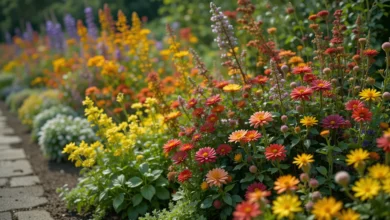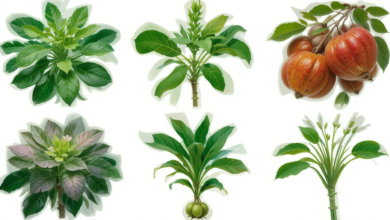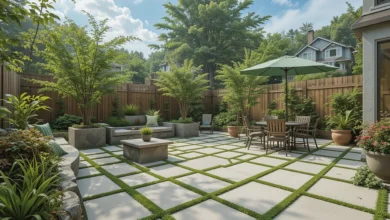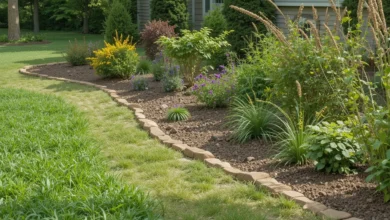8 Best Ground Covers for Pathways and Patios Between Pavers
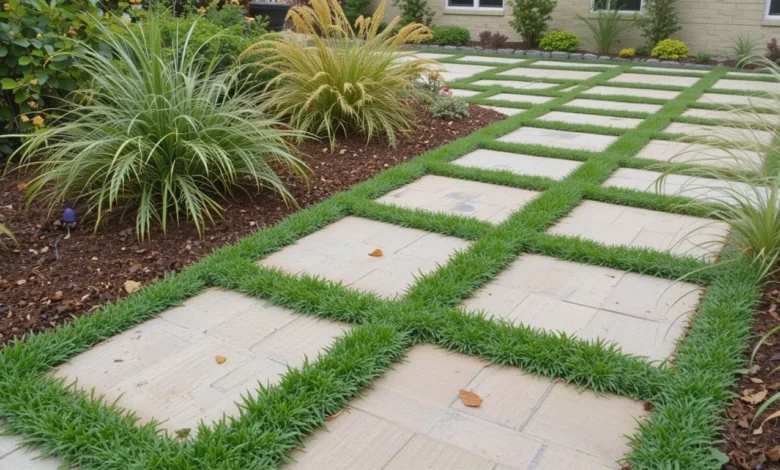
When it comes to creating a beautiful, functional outdoor space, pathways and patios play a crucial role. However, there’s one element that can take your garden design to the next level: the plants you use between your pavers. Ground covers are the perfect way to enhance your pathways and patios, adding greenery, color, and texture to the spaces between the pavers.
Ground covers are low-growing plants that spread easily and provide coverage for soil, preventing weeds from sprouting while also adding a lush look to your outdoor areas. In this guide, we’ll explore 8 of the best ground covers you can plant between pavers to make your pathways and patios look amazing. We’ll also provide tips on how to care for these plants to keep your outdoor spaces looking beautiful year-round.
Why Use Ground Covers Between Pavers?
Before we dive into the best ground covers, let’s discuss why ground covers are such a great addition to your pathways and patios:
- Weed Prevention: Ground covers fill in the gaps between pavers, making it harder for weeds to take root and grow.
- Aesthetic Appeal: They soften the look of hardscaping and create a natural, green finish that enhances the beauty of your outdoor space.
- Low Maintenance: Many ground covers require little care once established, making them a perfect choice for busy gardeners.
- Water Conservation: Ground covers help retain moisture in the soil and reduce water evaporation, making them eco-friendly and water-wise.
Choosing the Right Ground Cover for Your Pavers
When choosing a ground cover, there are a few factors to consider:
- Sunlight: Some ground covers prefer full sun, while others thrive in shade. Choose a plant that matches the sunlight conditions in your garden.
- Climate: Be sure to pick a ground cover that is well-suited to your region’s climate. Some plants are better for cooler climates, while others do well in heat.
- Maintenance: If you want low-maintenance plants, go for ground covers that are hardy, drought-tolerant, and require minimal care.
- Foot Traffic: If you walk on the area often, choose ground covers that are tough and can handle foot traffic.
Read More: 10 Best Border Plants for a Stunning Garden Edge
The 8 Best Ground Covers to Plant Between Pavers
Here are the 8 best ground covers that are perfect for planting between pavers, each offering unique benefits:
1. Creeping Thyme (Thymus serpyllum)
Creeping thyme is one of the best ground covers for filling the gaps between pavers. This low-growing plant is perfect for sunny spots and offers a pleasant fragrance when stepped on, making it a great choice for pathways.
- Height: 2–4 inches (5–10 cm)
- Sunlight: Full sun
- Watering Needs: Low (drought-tolerant once established)
- Benefits: Aromatic, attracts pollinators, low-maintenance
- Care Tips: Ensure good drainage; water moderately in dry periods.
2. Irish Moss (Sagina subulata)
Irish moss is a bright green, moss-like ground cover that grows well between pavers. It creates a soft, lush carpet that feels pleasant underfoot and thrives in both sun and partial shade.
- Height: 2–3 inches (5–8 cm)
- Sunlight: Full sun to partial shade
- Watering Needs: Moderate (keep soil moist, but well-drained)
- Benefits: Tolerates foot traffic, vibrant color, requires minimal care
- Care Tips: Avoid letting the plant dry out completely.
3. Corsican Mint (Mentha requienii)
If you’re looking for a fragrant ground cover, Corsican mint is a great choice. It has tiny, bright green leaves that release a minty scent when stepped on. This plant thrives in cooler climates and works best in shaded areas.
- Height: 1–2 inches (2.5–5 cm)
- Sunlight: Partial shade to full shade
- Watering Needs: Moderate (needs regular watering)
- Benefits: Fragrant, attracts pollinators, low-growing
- Care Tips: Prefers moist, well-drained soil.
4. Creeping Jenny (Lysimachia nummularia)
Creeping Jenny is a fast-growing ground cover that produces small, yellow flowers in late spring and summer. It has bright green leaves that turn golden yellow in the fall. It’s great for partially shaded spots and works well along walkways or patios.
- Height: 2–4 inches (5–10 cm)
- Sunlight: Partial shade to full sun
- Watering Needs: Moderate (keep soil moist)
- Benefits: Attractive foliage, tolerates some shade, low-maintenance
- Care Tips: Trim back in the fall to maintain its shape.
5. Sedum (Sedum spp.)
Sedum, or stonecrop, is a succulent ground cover that thrives in full sun and well-drained soil. This low-maintenance plant has fleshy, colorful leaves and tiny star-shaped flowers in late summer. It’s perfect for dry areas and doesn’t require much water once established.
- Height: 4–6 inches (10–15 cm)
- Sunlight: Full sun
- Watering Needs: Low (drought-tolerant)
- Benefits: Drought-resistant, attractive, and easy to maintain
- Care Tips: Water sparingly and ensure proper drainage.
6. Dichondra (Dichondra repens)
Dichondra is a low-growing, fast-spreading ground cover that forms a dense carpet of small, round leaves. It’s perfect for both sunny and partially shaded spots and creates a soft, green edge along pathways and patios.
- Height: 2–4 inches (5–10 cm)
- Sunlight: Full sun to partial shade
- Watering Needs: Moderate (prefers moist, well-drained soil)
- Benefits: Tolerates light foot traffic, fast-growing
- Care Tips: Trim regularly to keep it neat.
7. Blue Star Creeper (Isotoma fluviatilis)
Blue star creeper is a fast-growing ground cover with tiny blue flowers that bloom in spring and summer. It’s perfect for planting between pavers in sunny areas and adds color and texture to your pathways.
- Height: 2–4 inches (5–10 cm)
- Sunlight: Full sun to partial shade
- Watering Needs: Moderate (water regularly but ensure good drainage)
- Benefits: Beautiful blue flowers, fast-growing, low-maintenance
- Care Tips: Deadhead flowers to encourage more blooms.
8. Sweet Woodruff (Galium odoratum)
Sweet woodruff is a fragrant ground cover that grows well in shaded areas. It has small white flowers in the spring and dark green leaves that give a forest-like look to garden borders. It’s great for planting between pavers in areas with less sunlight.
- Height: 4–6 inches (10–15 cm)
- Sunlight: Partial to full shade
- Watering Needs: Moderate (keeps soil moist)
- Benefits: Fragrant flowers, low-growing, easy to care for
- Care Tips: Avoid letting it dry out during hot periods.
How to Plant Ground Covers Between Pavers
Now that you know the best ground covers for your pathways and patios, here’s how to plant them:
1. Prepare the Area
Start by cleaning the gaps between the pavers. Remove any weeds, grass, or debris from the area. If the soil is compacted, loosen it with a garden fork or shovel.
2. Choose the Right Plants
Pick the plants that are suited to your garden’s sunlight and soil conditions. Plant them according to the spacing recommended for each variety. Some ground covers, like creeping thyme, spread quickly, while others, like sweet woodruff, grow slower.
3. Plant the Ground Covers
Place your plants into the gaps between the pavers. Gently remove them from their pots and plant them so that the top of the root ball is level with the surface of the soil. Press the soil down gently around the roots to hold them in place.
4. Water the Plants
Water the plants well after planting. Keep the soil moist until the plants are established. After that, most of these ground covers will be low-maintenance and drought-tolerant.
5. Maintain the Plants
Regularly check the growth of your ground covers. Trim them back if they start to spread too much or if they’re covering the pavers too quickly. This will keep the path looking tidy and prevent the plants from becoming too invasive.
Conclusion
Adding ground covers between pavers is a simple and effective way to enhance the look of your garden’s pathways and patios. The eight plants we’ve mentioned here—creeping thyme, Irish moss, Corsican mint, creeping Jenny, sedum, dichondra, blue star creeper, and sweet woodruff—are perfect for creating a lush, vibrant border that’s both beautiful and functional. Choose the right plant based on your garden’s needs, and follow our tips for planting and care, and you’ll enjoy a stunning outdoor space all year long.

